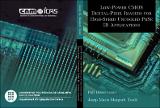Por favor, use este identificador para citar o enlazar a este item:
http://hdl.handle.net/10261/127544COMPARTIR / EXPORTAR:
 SHARE
BASE SHARE
BASE
|
|
| Visualizar otros formatos: MARC | Dublin Core | RDF | ORE | MODS | METS | DIDL | DATACITE | |

| Título: | Low-Power CMOS Digital Pixel Imagers for High-Speed Uncooled PbSe IR Applications |
Autor: | Margarit Taulé, Josep Maria | Director: | Serra Graells, F.; Terés Terés, Ll.; Madrenas Boadas, J. | Palabras clave: | CMOS image sensors MWIR PbSe Digital pixel sensor (DPS) Fixed-pattern noise (FPN) calibration High speed Infrared Low cost Low power Uncooled Neuromorphic |
Fecha de publicación: | nov-2015 | Editor: | Universidad Politécnica de Cataluña | Resumen: | This PhD dissertation describes the research and development of a new low-cost medium wavelength IR (MWIR) monolithic imager technology for high-speed uncooled industrial applications. It takes the baton on the latest technological advances in the field of vapour phase deposition (VPD) PbSe-based MWIR detection accomplished by the industrial partner NIT S.L., adding fundamental knowledge on the investigation of novel VLSI analog and mixed-signal design techniques at circuit and system levels for the development of the readout integrated device attached to the detector. The work supports on the hypothesis that, by the use of the preceding design techniques, current standard inexpensive CMOS technologies fulfill all operational requirements of the VPD PbSe detector in terms of connectivity, reliability, functionality and scalability to integrate the device. The resulting monolithic PbSe-CMOS camera must consume very low power, operate at kHz frequencies, exhibit good uniformity and fit the CMOS read-out active pixels in the compact pitch of the focal plane, all while addressing the particular characteristics of the MWIR detector: high dark-to-signal ratios, large input parasitic capacitance values and remarkable mismatching in PbSe integration. In order to achieve these demands, this thesis proposes null inter-pixel crosstalk vision sensor architectures based on a digital-only focal plane array (FPA) of configurable pixel sensors. Each digital pixel sensor (DPS) cell is equipped with fast communication modules, self-biasing, offset cancellation, analog-to-digital converter (ADC) and fixed pattern noise (FPN) correction. In-pixel power consumption is minimized by the use of comprehensive MOSFET subthreshold operation. The main aim is to potentiate the integration of PbSe-based infra-red (IR)-image sensing technologies so as to widen its use, not only in distinct scenarios, but also at different stages of PbSe-CMOS integration maturity. For this purpose, we posit to investigate a comprehensive set of functional blocks distributed in two parallel approaches: - Frame-based "Smart" MWIR imaging based on new DPS circuit topologies with gain and offset FPN correction capabilities. This research line exploits the detector pitch to offer fully-digital programmability at pixel level and complete functionality with input parasitic capacitance compensation and internal frame memory. - Frame-free "Compact"-pitch MWIR vision based on a novel DPS loss-less analog integrator and configurable temporal difference, combined with asynchronous communication protocols inside the focal plane. This strategy is conceived to allow extensive pitch compaction and readout speed increase by the suppression of in-pixel digital filtering, and the use of dynamic bandwidth allocation in each pixel of the FPA. In order make the electrical validation of first prototypes independent of the expensive PbSe deposition processes at wafer level, investigation is extended as well to the development of affordable sensor emulation strategies and integrated test platforms specifically oriented to image read-out integrated circuits. DPS cells, imagers and test chips have been integrated and characterized in standard 0.15-micron 1P6M, 0.35-micron 2P4M and 2.5-micron 2P1M CMOS technologies, all as part of research projects with industrial partnership. The research has led to the first high-speed uncooled frame-based IR quantum imager monolithically fabricated in a standard VLSI CMOS technology, and has given rise to the Tachyon series [1], a new line of commercial IR cameras used in real-time industrial, environmental and transportation control systems. The frame-free architectures investigated in this work represent a firm step forward to push further pixel pitch and system bandwidth up to the limits imposed by the evolving PbSe detector in future generations of the device. | URI: | http://hdl.handle.net/10261/127544 |
| Aparece en las colecciones: | (IMB-CNM) Informes y documentos de trabajo |
Ficheros en este ítem:
| Fichero | Descripción | Tamaño | Formato | |
|---|---|---|---|---|
| PhdThesis_JMMargarit_Rev.pdf | 27,28 MB | Adobe PDF |  Visualizar/Abrir | |
| 4819.pdf | Portada | 6,62 MB | Adobe PDF |  Visualizar/Abrir |
CORE Recommender
Page view(s)
489
checked on 18-abr-2024
Download(s)
2.252
checked on 18-abr-2024
Google ScholarTM
Check
NOTA: Los ítems de Digital.CSIC están protegidos por copyright, con todos los derechos reservados, a menos que se indique lo contrario.
